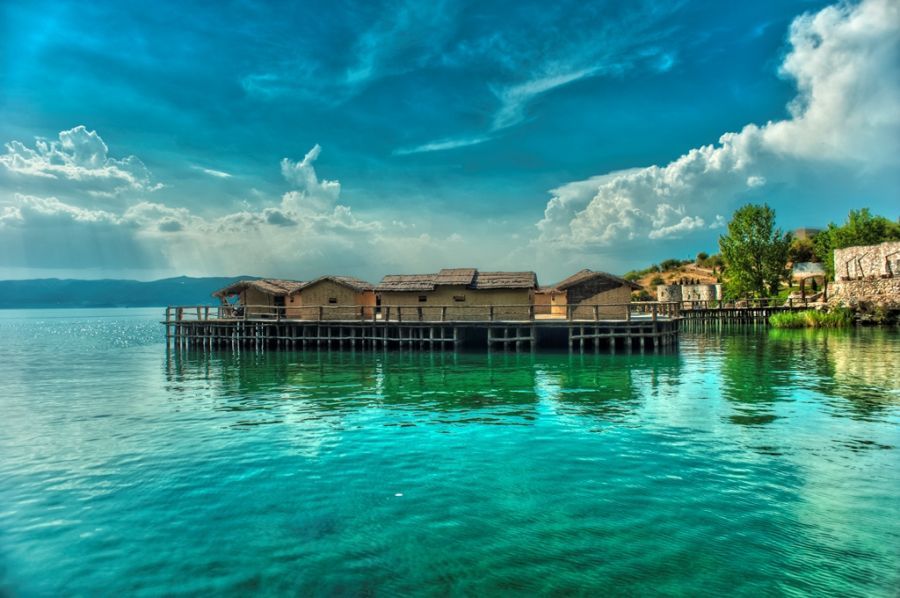Macedonia has three natural lakes, Lake Ohrid, Lake Prespa and Lake Dojran.
Lake Ohrid
Lake Ohrid (Macedonian: Охридско Езеро, Ohridsko Ezero) straddles the mountainous border between the southwestern Republic of Macedonia and eastern Albania. Lake Ohrid is the deepest lake of the Balkans, with a maximum depth of 288 m (940 ft) and a mean depth of 155 m (508 ft). It covers an area of 358 km2 (138 sq mi), containing an estimated 55.4 km³ of water. It is 30.4 km long by 14.8 km wide at its maximum extent with a shoreline length of 87.53 km, shared between the Republic of Macedonia (56.02 km) and Albania (31.51 km). The lake drains an area of around 2600 km² and is fed primarily by underground springs on the eastern shore (about 50% of total inflow), with roughly 25% shares from rivers and direct precipitation. Over 20% of the lake’s water comes from nearby Lake Prespa, about 10 km (6.2 mi) to the southeast and at 150 m higher altitude than Lake Ohrid.
While Lake Ohrid is special as such, by far the most spectacular quality is its impressive endemism. Similar to Lake Baikal or Lake Tanganyika, Lake Ohrid harbors endemic species covering the whole food-chain, from phytoplankton and sestile algae (20 species; e.g., Cyclotella fottii), over plant species (2 species; e.g., Chara ohridana), zooplankton (5 species; e.g., Cyclops ochridanus), cyprinid fish (8 species; e.g., Pachychilon pictus), to predatory fish (2 trout species; Ohrid trout Salmo letnica and “Belvica” Acantholingua ohridana) and finally its diverse endemic bottom fauna (176 species; e.g. Ochridagammarus solidus), with particularly large endemism among crustaceans, molluscs, sponges and planarians.
There are three cities on the lake’s shores: Ohrid and Struga on the Macedonian side; Pogradec in Albania. There are also several fishing villages, although tourism is now a more significant part of their income. The catchment area of the lake has a population of around 170,000 people, with 131,000 people living directly at the lake shore (43,000 in Albania and 88,000 in the Republic of Macedonia).
Lake Prespa
The Great Prespa Lake (Macedonian: Преспанско Езеро, Prespansko Ezero) is divided between Albania, Greece and the Republic of Macedonia. The biggest island in the Great Prespa Lake, on the Republic of Macedonia’s side, is called Golem Grad (“Large Fortress”), or Snake Island (Змиски Остров). The other island Mal Grad (“Small Fortress”, in Albania) is the site of a ruined 14th century monastery dedicated to St. Peter. Today, both islands are uninhabited. (See also :List of islands of the Republic of Macedonia).
Because Great Prespa Lake sits about 150m above Lake Ohrid, which lies only about 10 km (6.2 mi) to the west, its waters run through underground channels in the karst and emerge from springs which feed streams running into Lake Ohrid.
Dojran Lake
Dojran Lake, located in southeastern Macedonia, is the smallest of the three major lakes with an area of 42.7 km². It is shared between the Republic of Macedonia (27.1 km²) and Greece (15.6 km²).[15] The town of Dojran is situated on the west coast of the lake, while the Greek village of Mouries lies to the east. To the north is the mountain Belasica and to the south is the Greek town of Doirani. The lake is round in shape, has a maximum depth of 10 metres, has a north-to-south length of 8.9 km, and is 7.1 km at its widest.[16]









